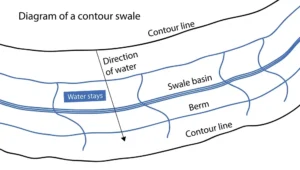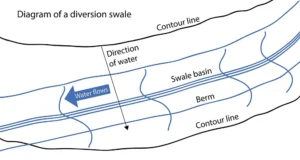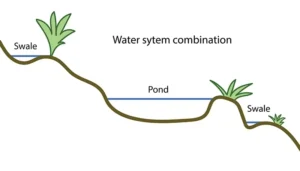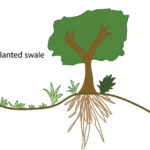 Would you like to make the most of the rainwater that falls on your land instead of having it just drain away? Swales may be what you are looking for.
Would you like to make the most of the rainwater that falls on your land instead of having it just drain away? Swales may be what you are looking for.
A swale is an excavated depression on the ground to slow, absorb and direct rainwater. A cross-section of the basic swale construction is shown in the top left diagram. The ground is dug out at 15-30cm deep, and the excavated soil is piled onto a new bank 90-120cm wide on the lower slope, forming a berm. Both the basin and the berm have a gentle landform.
When it rains, the swales slow down the waterflow of the original slope and capture the runoff by spreading it horizontally across the swale basin. This way the swales arrest the process of erosion, facilitate infiltration into the soil and reduce pollutants. There are different types of swales and they can be used in several ways.
 Contour Swales
Contour Swales
A contour swale follows the landscape’s contour and all the swale basin is constructed at the same elevation level. They are useful to harvest rainwater and are popular in permaculture. Contour swales catch rainwater as it drains downhill and hold it in place along the contour until it is absorbed evenly into the ground. They look like a massive ditch with closed ends, and they trap the water as opposed to letting it flow away.
 Diversion Swales
Diversion Swales
Diversion swales are constructed with a little inclination to one or both sides, so the water moves slowly towards the lower end(s). As opposed to contour swales, diversion swales don’t aim to keep all the rainwater in place until it’s absorbed. They are meant to slow down the rainwater movement, allow it to be partially absorbed, prevent erosion and catch sediments, while slowly steering it somewhere else like to another swale or to a reservoir.
Rainwater management is only one function of swales. Another important function is to be a tree growing system. Trees take advantage of swales by utilizing the water collected to grow and in return, they stabilise the landscape, moderate saturation levels and provide shade that will reduce evaporation. Over time, landscapes with swales will become more hydrated, making them more drought resilient.
 The berm of a swale is the perfect place to grow trees and deep rooted plants. The organic matter and sediment carried from uphill are deposited at the bottom of the swale creating fertile ground. As the plants absorb the moisture from below, the soil will not become over-saturated. If swales are built at the bottom of a chicken run or grazed grassland, they will absorb the manure-loaded runoff and concentrate it in a location where you can make use of the nutrients instead of letting them wash downslope where they could become a pollutant.
The berm of a swale is the perfect place to grow trees and deep rooted plants. The organic matter and sediment carried from uphill are deposited at the bottom of the swale creating fertile ground. As the plants absorb the moisture from below, the soil will not become over-saturated. If swales are built at the bottom of a chicken run or grazed grassland, they will absorb the manure-loaded runoff and concentrate it in a location where you can make use of the nutrients instead of letting them wash downslope where they could become a pollutant.
 Used in combination with dams, ponds and grey water systems, swales can absorb overland flows and passively release excess water to soak across the landscape.
Used in combination with dams, ponds and grey water systems, swales can absorb overland flows and passively release excess water to soak across the landscape.
Article and diagrams by Daniel Tay Chean
Land for Wildlife Officer
Tooowoomba Regional Council
